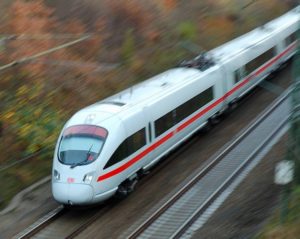
Nuclear had been the favored source of electricity in the train operators plans, but the decision by he German government to close its nuclear plants after the Fukushima meltdown has forced a change of plan.
So now, Germany’s 5,700 train stations will sport photo-voltaic panels. In the case of the rather impressive station in Berlin, the Hauptbahnhof, those panels produce 160,000 kilowatt hours of electricity each year, about 2% of the station’s needs. Overall, the systems requires 12 terawatt hours (recalling that mega is million, giga is billion, and tera is trillion). It’s about as much as the city of Berlin uses for the needs and wants of its 3.2 million citizens.
Train aficionados and train-spotting anoraks will tell you that trains are vastly greener than planes or cars. The New York Times reports, “Even high-speed trains, which zip across the country at as much as 300 kilometers, or 185 miles, per hour, have carbon emissions of 46 grams per passenger per kilometer, or about 2.6 ounces per passenger per mile, compared with an average of 140 grams for cars and 180 for planes.” By greening up its electrical consumption, those 46 grams will decline farther.
One of the big problems in getting renewable energy off the ground has been economics. In order for various new technologies to become economically competitive with dirtier traditional sources of power, you need economies of scale. Deutsche Bahn is a big enough actor on the transportation stage that some serious economies can be realized in fulfilling its orders – much as the US military’s interest in non-fossil fuels has grown.